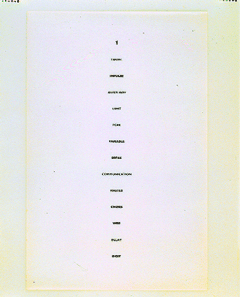Robert Barry’s innovations can’t easily be articulated, but still hold sway
Before the computer, there was the word processor. Before the word processor, the typewriter. Before Photoshop, there was the page, the manual margin set and the eye. And so we reach back to works by Robert Barry, circa the young ‘70s, when the typeset letter on a page represented a bold assertion––that art can be without substance.
In the beginning, as the Apostle John would have it, was the word.
Twelve of Robert Barry’s “Drawings from the Seventies” are currently on view at Gasser & Grunert Gallery. The works, spare letterset and letterset and pen on vellum, engage the debate over the primacy of concept in art. In some sense, of course, that battle has been fought and forgotten—conceptual art has become intrinsic to the discussion of painting, sculpture and performance. Yet the clarity of Barry’s words on paper, words on grids, lays out the assertion with a sparser recourse to intellect and technique.
To look on the battle over art through the previous century—the struggle to commandeer creativity from clichés and from the political atavism of universality and timelessness—is to witness, ultimately, a losing effort.
Concept was once an intrusive demand, but it has now become no more than an element of the tried-and-true, tired-and-trite. In the course of several years in the art world, one will doubtlessly encounter dozens of meat sweaters, cow carcasses, blood-soaked performances, orgies, manufactured advertisements for ersatz products and more of that ilk. Meanwhile, the maudlin sculptures of wide-eyed figures continue to linger. And all of that art, despite stated philosophical mutinies, will strive to “resonate.” The works will be intended to “stir your soul,” just, as any fourth-grade teacher in 1905 would have told you, they should.
Recreating the revolution of the ‘60s and ‘70s in art as a mere typed word on a page is impossible—and to this time, the perishability that implies is the impact of Barry’s drawings. The work, as per his original intention, is defined largely by what it isn’t––that is, material––or can’t be––that is, contemporary.
The present day is stumbling upon its own clarities, and the free-for-all of the art scene has eroded many antiquated pretensions—but a willingness is spelled out in the still words of Barry, in the earliest work in the Gasser & Grunert hanging, (1970, Untitled):
IT CAN BE INFLUENTIAL
IT IS OPEN TO NEW POSSIBILITIES
ANY PART OF IT MAY CEASE TO EXIST AND NEVER RETURN
IT CANNOT BE COMPLETELY ISOLATED
SOME OF IT CAN NEVER BE KNOWN
SOME OF IT IS COMMON KNOWLEDGE
gaycitynews.com


































